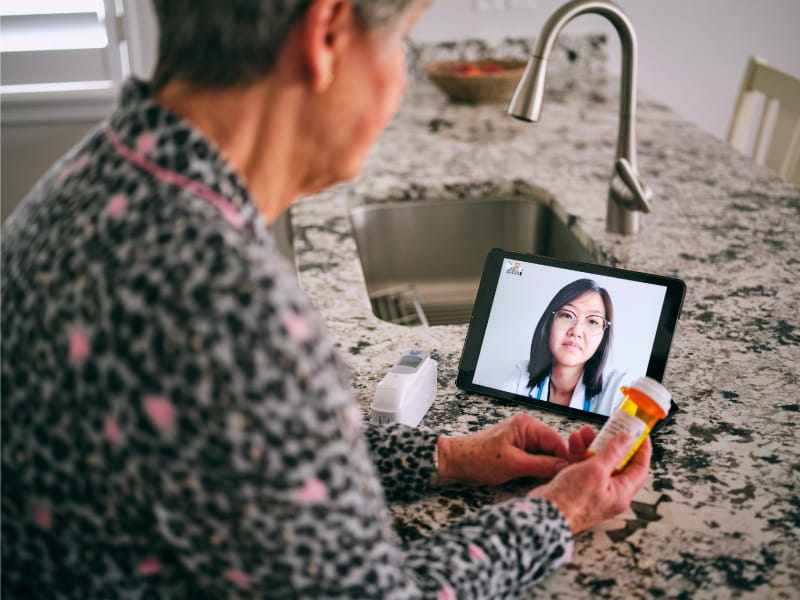Video doctor visits gain ground during coronavirus pandemic
By American Heart Association News

Dr. David Wheeler started seeing patients via telehealth in his Wyoming neurology practice 10 years ago as a way to provide routine visits to patients living in remote areas. He'd see three to four patients by video or telephone chat each day, which only made up about a fifth of his regular practice.
Then the new coronavirus began to spread across the nation. Now, even though Wyoming has a relatively low number of positive COVID-19 cases, he said, every patient is being rescheduled to a virtual visit. His staff works from home.
"We're trying not to reproduce everyone else's mistakes" by waiting too long to restrict community exposures, Wheeler said. "We are doing all encounters virtually now. I expect to be doing this for several weeks or months."
This is telemedicine's moment.
Already on the rise prior to the current public health crisis, it is fast becoming a critical tool in preventing exposures, as well as freeing health care workers and supplies to alleviate the stress on health systems in hard-hit areas.
At Boston Medical Center, the teaching affiliate for Boston University School of Medicine – and the busiest trauma and emergency services center in New England – telemedicine was rarely used prior to the novel coronavirus outbreak.
"We had no clinical capability for this," said Dr. Rebecca Grochow Mishuris, an internal medicine physician and associate chief medical information officer at BMC. "We are now fully up and running with telemedicine. We did it in 48 hours."
Mishuris said BMC is now scheduling telephone visits at a rate of about 1,500 per day. They've also started video chat visits.
The federal government eased the way in mid-March by loosening HIPAA regulations to allow Medicare reimbursement for medical consultations using technologies such as Skype, FaceTime and Zoom. And in 42 states and Washington, D.C., private insurers are mandated to provide at least some coverage of telemedicine services. Wheeler said private insurers in his state are beginning to follow suit.
"We now have a reasonable expectation that we can get paid," said Wheeler. "This is helping us to keep the doors open since we also have to stop providing elective procedures and that's causing us to lose money."
People having symptoms of a heart attack, stroke or other health emergency should still call 911. But for those wondering when to use telephone or video visits instead of in-person visits, experts say people should call their physicians, who are making decisions case-by-case.
"We can't do everything over the phone or by video, but we can do a lot," Mishuris said. "A patient can show you a rash, you can see if they are breathing too quickly, if there is a facial droop. A lot of medicine is just hearing the patient's history and understanding what their current state is and how they think they got there.
"In the current situation, we might say come in in three months but call me if x, y or z happens," she added.
Doctors conducting audio or video visits will guide patients on how to present their symptoms, Mishuris said – even if they can't see them. For example, "They might ask you to open your mouth and stick out your tongue in front of a mirror and tell us what you see. But if we hear something on this visit that makes us think you need to come in, we'll tell you and we'll explain the risks to you."
Likewise, Kaiser Permanente, which had been greatly increasing its use of telemedicine for several years, has moved to using telehealth visits as a default.
"Our doors are still open to patients who need to be seen," said Dr. Edward Lee, the telemedicine leader for Kaiser Permanente in northern California and for the Permanente Federation. "But we're trying to shift every initial visit to telehealth."
Doctors there see the patient first by video to get an initial assessment, he said. Then, using clinical judgment, they determine what to treat through telehealth and what requires an in-person visit.
"You have to weigh the risk of the patient going out and being exposed to the virus against what it is they are calling about," Lee said.
Patients who aren't tech savvy should not be concerned about trying telehealth, he said. "The nice thing is that it's not complex technology and it's almost universally available. All you need is a smartphone. Most people have that."
For those who don't, there are other ways to communicate with physicians from a distance, Lee said. Regular phone calls made from landlines can be scheduled. Kaiser Permanente also does "millions of secure email communications with patients per year. We can answer questions to many common health concerns in this way."
Editor's note: Because of the rapidly evolving events surrounding the coronavirus, the facts and advice presented in this story may have changed since publication. Visit Heart.org for the latest coverage, and check with the Centers for Disease Control and Prevention and local health officials for the most recent guidance.
If you have questions or comments about this story, please email [email protected].





